From Annapolis to Asia

Annapolis campus President Pano Kanelos was recently invited to speak at a conference on the liberal arts in Daegu, South Korea. While there, he took the opportunity to meet with higher education professionals and students throughout South Korea, Singapore, and China, where he was joined by Vice President of Enrollment Benjamin Baum.
Is liberal arts education prevalent in the countries you visited?
Well, it’s on the rise. That’s why I was invited. University systems there tend to be very discipline-specific and technically-oriented, and there are a lot of people in higher education who are wondering whether that’s the best model, or whether they should open up the universities to have something more like a liberal arts model.
You mentioned that St. John’s is fairly well-known in East Asia. Why do you think that is?
We have a lot of historic connections, particularly with Korea and China, where St. John’s is considered to be kind of the archetypal liberal arts school. We have a lot of alumni from these countries who have had positive experiences and return, including Hanbyul Cho (SF14) whose book “How St. John’s Studies Classics and Great Books” was published in Korea and widely read.
We have a significant number of international students; our international student population is about 20 percent of the student body. Right now, I think the two single countries from which we get the largest number of students are China and Korea.
You visited a number of schools throughout South Korea, Singapore, and China. What were those visits like?
Each school was a little bit different, but we met with guidance counselors and teachers who talked to us about their school and their students, and then we got a chance to meet with some of the students who were interested in St. John’s. Some of the groups were rather large—a couple hundred students in some cases—and in others, the parents were also there and interested. We had meetings with students and parents about the value of arts education. The audience was curious and well-informed—everybody had done the research, and the questions were very advanced. Instead of saying “Tell me about the Program,” a student would ask “Why do you read this particular book in junior year?” The curiosity was really extraordinary.
It was fun. It was interesting to get a chance to talk about the college in a setting where people are less familiar with American higher education and the liberal arts. It gave me a fresh perspective on what we do, thinking about what would make a young person decide to travel across the world to go to St. John’s.
Were most students and parents receptive to the idea of a liberal arts education?
From the parents, the same question tended to arise that arises with parents here [in the United States]: What’s the connection between a liberal arts degree and a profession? I was able to talk to them and explain how, in fact, a lot of the data now is showing that companies are more interested in liberal arts majors and that liberal arts majors have a better career trajectory to a large degree. I think it was comforting to them to show the statistics. The same concerns are worldwide—higher education is expensive and takes time, and everybody wants to understand better what the end point of it can be.
I heard many students say that their education was often centered around mastering information or memorizing things, and that there wasn’t much space for discussion. The seminar-style approach was not something they were familiar with, so they were very intrigued by it. One of the things I often say is that higher education shouldn’t just be about transferring information, it should be about transformation. A good liberal arts education really is focusing on the transformative effect of higher education on individual students. It’s not just about mastering a kind of discipline or a body of knowledge, but mastering the arts of understanding.
Do you think the trip will result in increased enrollment from East Asian countries?
There were a lot of students that I met with who showed interest in applying, and I think it would be great. We love our international students. We always talk about Johnnies being needles in the haystack, and I think there are needles all over the world. We want to make sure that whoever wants to be a Johnnie can be a Johnnie.
Do you have plans for similar international travel?
Nothing planned yet, but there’s a network of schools called the United World Colleges (UWC) that we get quite a number of students from. They’re located globally—we visited three UWC schools in Asia, and I do feel the UWC schools in particular have an affinity for what we do at St. John’s. I think reaching out to those schools and a few other locations is something that we need to be focusing on. Whether I’ll be the one to do that directly or not, I’m not sure.
Any other highlights of the trip?
Great, great dumplings.
6 photos
President Pano Kanelos Visits East Asia
Annapolis campus President Pano Kanelos recently took a trip to China, Singapore, and South Korea to promote St. John’s and the liberal arts.
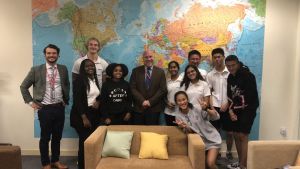
United World College Students in Singapore
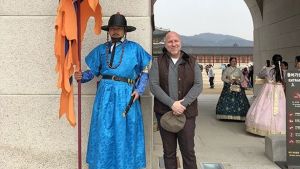
The National Palace in Seoul, South Korea.
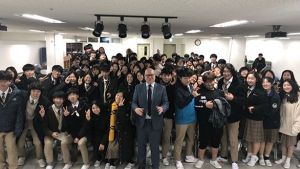
Pano with a large group of students in Seoul, South Korea.
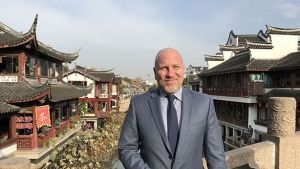
President Kanelos visits Shanghai.
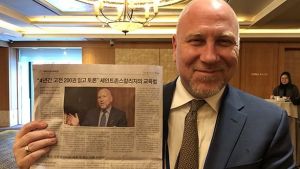
Pano poses with JoongAng Ilbo newspaper, in which he was featured, in Seoul.
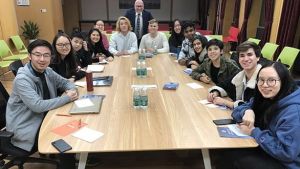
United World College Students in Shanghai.

